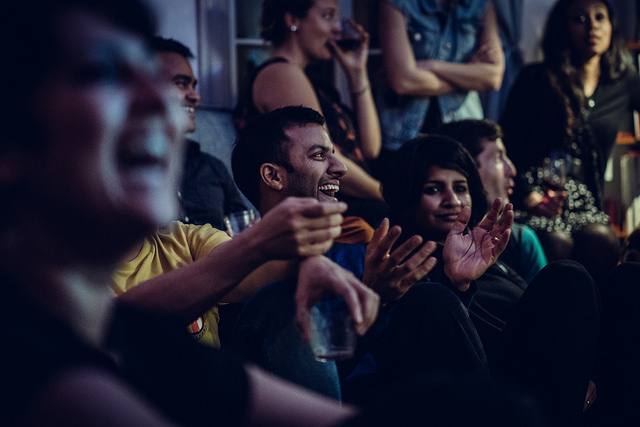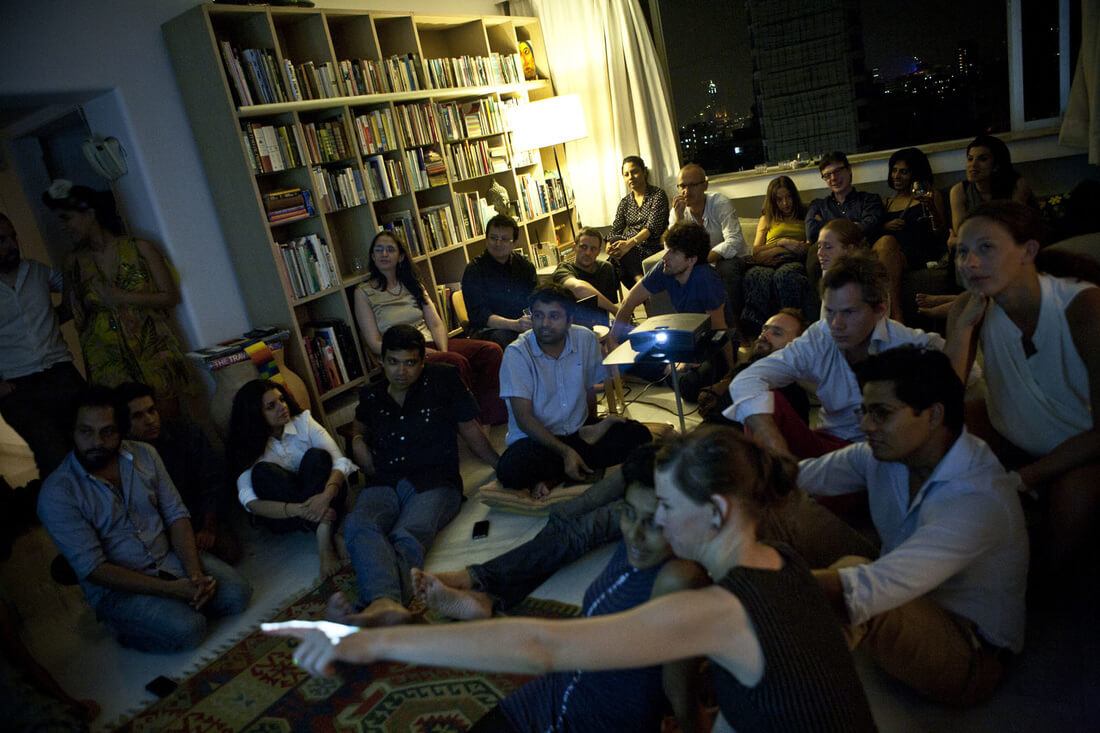Intent
Architecture and design have a profound influence on the quality of life. They echo the cultural-artistic-aesthetic sensibilities and aspirations of a nation and its people.
The MAD Salon aspires to catalyze a movement to make architecture and design more relevant. It provides a platform for passionate discourse and debate.
Originally conceived to focus on architecture and design as primary elements of nation building, it has morphed into a lens to look at a broader narrative: culture, aesthetics, the arts, the city, social interaction, mobility, human behavior, politics, economics, urbanism, and more.
Design
The MAD Salon is usually hosted on Saturday evenings in the living room-cum-studio-cum-atelier of the MAD founders. The Salon starts with food and drinks and slowly the guests ease into the presentation for the evening. Guests sit around in an informal cluster and engage in an interactive presentation that allows for fluid discussions with minimal or no moderation from the hosts. The idea is to have an immersive intellectual exchange while blurring the lines between the expert and the enthusiast. The living room format makes the Salon an intimate affair and generates impassioned debates. Some editions of the MAD Salon have been hosted outside at the Kala Ghoda Café and at Studio-X in Mumbai.
The MAD founders consciously steered away from the proscenium format where the action is on a stage (real or imaginary) and the audience sits in front. Information flow is perceived to be unidirectional and the degree of immersion depends on how far you are from the presenter. Instead, the founders wanted to recreate the experience of an intimate immersive setting of the classic Indian ‘adda’, where say half a dozen friends are sitting around, lounging, discussing, arguing over chai or coffee – but with a multiplier effect – for say 30 people – friends and friends of friends.
The MAD Salon, by design, is a casual affair, intellectually serious, but socially friendly. During the Salon, the guests sit all around – on the sofas, on chairs, on butt-perches, on cushions, on the floor or even stand if they like. The MAD Speaker is embedded in the audience in a way that he / she feels part of the immediate social circle and can converse freely, which lends intimacy to the event.
The secret draw of the MAD Salon is its unique chemistry, informality, interactivity, immersion quotient, deep interrogative tendencies and the fact that each get-together is individually curated. The MAD hosts take care of all the ingredients that go into the making of a MAD evening - the invitations, the groceries, the cooking, the cleaning, the concocting, the food, the drinks, the music, the lighting, everything. Nothing is outsourced. No databases. No mass mailings. No two salon invites look the same. No two salons have the same mix of people.
The MAD Salon debuted in October 2010. The debut speaker was Adrien Gardere, Parisian designer and museographer, who was at the time designing the exhibition space at Musée du Louvre-Lens, and had recently concluded a museum design commission at the Museum of Islamic Art in Cairo. The Salon editions since the debut have explored areas relevant to India’s burgeoning super-dense urban life, through a kaleidoscope of perspectives - contemporary architecture, traditional practices, urban issues, spacecraft design (compact living), heritage appreciation, museum design, visual art and restoration architecture.
Editions
Bangalore
Edition #20, 03.2017 Abhimanyu Arni historian
Prashant Keshavmurthy professor of persian-iranian studies
Edition #19, 06.2016 Pierre Bertrand technologist, explorer
Edition #18, 06.2016 Aliyeh Rizvi writer, information + experience designer
Ryan Lobo film maker, photographer
Edition #17, 02.2016 Anjum Hasan novelist, short story writer, poet, editor
Zac O’Yeah detective, travel writer, literary critic, columnist
Edition #16 ,09.2014 Vijay Padaki actor, director, trainer, writer
Mumbai
Edition #15, 03.2014 Meera Sanyal banker, politician
Edition #14, 12.2013 Rafeeq Ellias photographer, film maker
Edition #13, 12.2013 Siddharth Sthalekar generosity entrepreneur
Edition #12, 08.2013 Rohit Goel political philosopher
Edition #11, 07.2013 Nandita Das actor, director, social activist
Edition #10, 03.2013 Pranesh Prakash policy expert: internet censorship + freedom
Edition #9, 10.2012 Ranjit Hoskote poet, cultural theorist, critic, and curator
Edition #8, 09.2012 Barbara Imhof aerospace architect
Edition #7, 06.2012 Sameep Padora architect
Edition #6, 01.2012 Sooni Taraporewala screenwriter, photographer, film maker
San Francisco
Edition #5, 08.2011 Sebastien Raduoan architectural historian
Edition #4, 05.2011 Mathias Echanove, Rahul Srivastava urbanologists
Edition #3, 02.2011 Vikas Dilawari architect and conservationist
Edition #2, 01.2011 Kapil Gupta architect
Edition #1, 10.2010 Adrien Gardere designer and museographer
The Making of the San Francisco Edition

Photo Credit Hugo Ahlberg

Photo Credit Hugo Ahlberg
The MAD Salon can be infectious, but never commercial. It has the potential to spread in organic ways, as was evident in the genesis of the San Francisco (SF) edition.
The SF edition of the MAD Salon was curated by IDEO designers, friends and (at one point) roommates - Priti Rao and Annette Diefenthaler. The duo hosted a series of editions at their lovely home in the historic Alamo Park neighbourhood for a couple of years starting 2014.
Prior to moving to San Francisco, Priti was in Mumbai and attended the Mumbai editions of the Salon at Sid and Suz’s residence.
Here’s what inspired Priti to curate and host the SF edition with Annette:
“Personally for me, my best memories of Bombay were the MAD Salons at Sid and Suz home. It was cosy, I met the loveliest people. I liked that it welcomed everyone, there was no charge, and the hosts made the food themselves. We haven't managed to do a second meal tradition yet here in San Francisco, but everything else is pretty much the same. I think it's a fairly non-western concept to offer food to 40 peeps each time. But over time, we've developed an informal team who do cocktails and take care of DJ-ing, make invites. If I hadn't found the perfect partner in Annette who was equally MAD in saying yes to the idea this would never have happened, and despite our crazy schedules we still somehow manage to make it happen!”
As for Annette, here’s what she had to say:
“We started doing MAD because we both were new to the city and wanted to meet interesting people. We loved the idea of being able to connect with other people through interesting conversations that were stimulated by an awesome speaker. We asked our speakers to share less the result, and more the process of their work – questions they work through, the behind the scenes, which lead to the most interesting conversations.
We intentionally look to find a mix of topics – more and less serious, some more artsy, others more intellectually complex. We intentionally curate the audience to be (a) only few (active) IDEO-ers, and (b) people who will enjoy connecting with each other. Doing intros in the beginning has unearthed really fun connections between people at the event.”
2nd Anniversary of the Mumbai Edition

Photo Credit Aparna Jayakumar
The second anniversary edition of the Salon took place on 20 October 2012. The MAD Speaker for this special edition Salon was poet, cultural theorist and curator Ranjit Hoskote who spoke about the Biennale as a cultural catalyst. Ranjit has been, among other things, the co-curator of the 2008 Gwangju Biennial in South Korea, the curator of India’s first-ever national pavilion at the 2011 Venice Biennale and is a member of the international advisory board for the 1st Bergen Triennial, Norway.
The MAD founders and devotees couldn't have hoped for a more fitting second anniversary edition. Somewhere between 35 to 40 people showed up. It was a MAD with many firsts - not counting precocious young Reza (all of 7!) who opened the Salon with his introduction of the 16th century Italian painter Giuseppe Arcimboldo and Venice.
This was longest and the most animated MAD yet. It was also the only one with an intermission. And unlike most such gatherings that lose steam after a break, this one actually picked up energy, like a second wind. Audience engagement was palpably higher. By the time, the MAD crowd wound up with some espresso and cake it was midnight.
Ranjit (Hoskote) blended right in and did not mind the fact that the Salon spilled over a bit on both sides - both in terms of time and people and the discussions. This is exactly how the MAD Salons are intended to be.
Riyas (Komu), artist and co-founder of the Kochi-Muziris Biennale was there too and so was Nancy (Adajania), cultural theorist and Joint Artistic Director of the 2012 Gwangju Biennale - which made the Biennale discussion come full circle.
